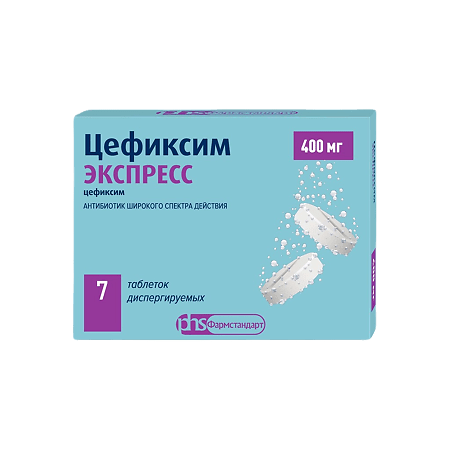No products in the cart.
Cefixim EXPRESS, 400 mg 7 pcs
€18.10 €15.08
Description
Pharmacodynamics
Cefixime is a broad-spectrum semi-synthetic antibiotic of cephalosporin III generation for oral administration. It has a bactericidal effect. The mechanism of action is associated with inhibition of bacterial cell wall synthesis. Cefixime is resistant to β-lactamases produced by many Gram-positive and Gram-negative bacteria.
The spectrum of antimicrobial activity
In clinical and in vitro efficacy of cefixime has been confirmed in infections caused by Streptococcus pneumoniae, Streptococcus pyogenes, Haemophilus influenzae, Moraxella catarrhalis, Escherichia coli, Proteus mirabilis, Neisseria gonorrhoeae.
Cefixime also has activity in vitro against Gram-positive – Streptococcus agalactiae and Gram-negative bacteria – Haemophilus parainfluenzae, Proteus vulgaris, Klebsiella pneumoniae, Klebsiella oxytoca, Pasteurella multocida, Providencia spp. Salmonella spp., Shigella spp., Citrobacter amalonaticus, Citrobacter diversus.
Pseudomonas spp., Enterococcus spp., Listeria monocytogenes, most strains of Enterobacter spp., Staphylococcus spp. (including methicillin-resistant strains), Bacteroides fragilis, Clostridium spp.
Pharmacokinetics
Absorption
In oral administration the bioavailability is 40-50% and is independent of food intake. Maximal concentration in plasma (Сmax) in adults after oral administration of 400 mg is reached after 3-4 hours and is 2.5-4.9 µg/ml, after 200 mg – 1.49-3.25 µg/ml. There is no significant effect of food on absorption of the drug from the gastrointestinal tract (GIT).
Distribution
The volume of distribution when administered 200 mg of cefixime was 6.7 l, when reaching equilibrium concentration – 16.8 l. About 65% of cefixime binds to plasma proteins. The highest concentrations of cefixime are in urine and bile. Cefixime penetrates through the placenta. The concentration of cefixime in umbilical cord blood reached 1/6-1/2 of the drug concentration in maternal plasma; the drug was undetectable in breast milk.
Metabolism and excretion
The elimination half-life in adults and children is 3-4 h. Cefixime is not metabolized in the liver; 50-55% of the administered dose is excreted unchanged in the urine within 24 hours. About 10% of cefixime is excreted with the bile.
Pharmacokinetics in special clinical situations
In patients with renal insufficiency a longer half-life and correspondingly higher concentration of the drug in plasma and delayed elimination by the kidneys can be expected. In patients with creatinine clearance of 30 ml/min when administering cefixime 400 mg the half-life period is increased up to 7-8 h, maximum concentration in plasma is on average 7.53 µg/ml, and excretion with urine within 24 h – 5.5%.
In patients with cirrhosis, the half-life increases to 6.4 h, the time to reach maximum concentration (TSmax) – 5.2 h; simultaneously, the proportion of the drug eliminated by the kidneys increases. Cmax and area under the pharmacokinetic curve do not change.
Indications
Indications
Infectious inflammatory diseases caused by microorganisms sensitive to the drug:
Active ingredient
Active ingredient
Composition
Composition
How to take, the dosage
How to take, the dosage
Interaction
Interaction
Special Instructions
Special Instructions
Due to the possibility of cross-allergic reactions with penicillins, it is recommended that patient history be carefully evaluated. If an allergic reaction occurs, the drug should be discontinued immediately.
In case of toxic epidermal necrolysis (Lyell’s syndrome), Stevens-Johnson syndrome, drug rash syndrome with eosinophilia and systemic manifestations, cefixime should be stopped and appropriate therapy should be given.
In case of development of anaphylactic shock the drug should be discontinued, epinephrine (adrenaline), systemic glucocorticosteroids and antihistamines should be administered.
In prolonged use of the drug it is possible to disrupt normal intestinal microflora, which may lead to excessive proliferation of Clostridium difficile and development of pseudomembranous colitis. In the case of milder forms of antiioic-associated diarrhea, it is usually sufficient to discontinue the drug. In more severe forms, corrective treatment (e.g., oral administration of vancomycin 250 mg 4 times daily) is recommended.
Antidiarrheals that inhibit gastrointestinal motility are contraindicated in pseudomembranous colitis.
Like other cephalosporins, cefixime may cause acute renal failure accompanied by tubulointerstitial nephritis. In case of acute renal failure, cefixime should be discontinued, appropriate measures taken and/or appropriate treatment administered.
In case of simultaneous use of Cefixime EXPRESS with aminoglycosides, polymyxin B, colistimethate sodium, “loop” diuretics (furosemide, etacrynic acid) at high doses, renal function should be controlled. After long-term treatment with the drug Cefixime EXPRESS the state of hematopoiesis function should be checked.
Dispersible tablets should be dissolved only in water. During treatment, a false-positive direct Coombs reaction and a false-positive urine glucose reaction are possible when using some rapid diagnostic test systems.
Contraindications
Contraindications
Elderly age, renal failure, colitis (history), pregnancy.
Side effects
Side effects
Overdose
Overdose
Pregnancy use
Pregnancy use
Similarities
Similarities
Additional information
| Shelf life | 2 years. |
|---|---|
| Conditions of storage | At a temperature not exceeding 25 ° C in the original package (in carton packs). Keep out of reach of children. |
| Manufacturer | Lekko ZAO, Russia |
| Medication form | dispersible tablets |
| Brand | Lekko ZAO |
Related products
Buy Cefixim EXPRESS, 400 mg 7 pcs with delivery to USA, UK, Europe and over 120 other countries.















